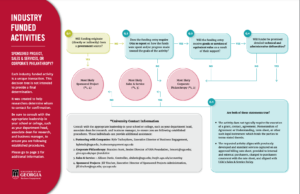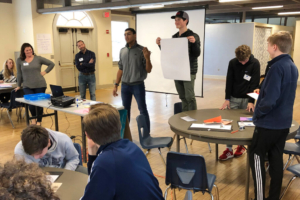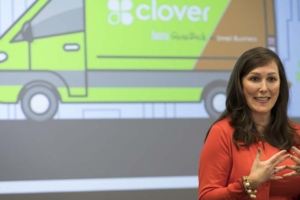At A Glance
Explore templates, documents, and other resources designed to help UGA faculty engage with industry and business partners. We welcome your feedback about these materials at any time.
Overview
The Business Engagement Toolkit for Faculty is one of several strategic investments the University of Georgia is making to support faculty in their collaborations with industry. The Office of Business Engagement, Innovation Gateway, Sponsored Projects Administration, and other university offices are available to smooth the path to successful, rewarding industry partnerships. As you engage with industry, be sure to consult with the appropriate leadership in your school or college, such as your department head, associate dean for research, and business manager, to ensure you are following established procedures.
In addition, UGA is a member of the University-Industry Demonstration Partnership (UIDP), a solutions-oriented organization where academic and industry members collaborate to develop new approaches to working together. The UGA Business Engagement Toolkit for Faculty includes numerous links to UIDP resources which you can easily access. Please note that all UIDP resources are copyright protected and should be treated accordingly. Many UIDP resources are available only to members. To gain member access, use your UGA email address and register here.
This 20-minute video provides a brief description of each of the tools. If you have questions or need additional assistance, please complete this form to connect with a member of the Office of Business Engagement team.
Industry funding: a complement to government grants
Knowledge creation and technology development require considerable capital investments. The US federal government continues to be an important source of support for all R&D-performing sectors and remains the largest funder of basic research. The share of federally funded R&D, however, has been declining since 2010 (from 31% in 2010 to 20% in 2019), and the share of federally funded basic research has also declined (from 52% in 2010 to 41% in 2019).[1] At the same time, competition for federal, state, and local funding has increased. Industry-sponsored research, in the form of grants, contracts (such as consulting agreements), and collaborative training programs, is a reliable alternate source of funding and offers many additional benefits to faculty, students, and the university overall.
Footnotes:
[1] Research and Development: U.S. Trends and International Comparisons | NSF – National Science Foundation
Evolution of university-industry partnerships
Science historians have traced collaboration between European companies and universities back to the 1800s, and in the United States, university-industry relationships have been around since the industrial revolution. Traditionally, industry partnered with universities to identify and train future employees. Over the last several decades, companies have increasingly recognized and sought out faculty who create the cutting-edge knowledge and technology central to university research — and critical to commercial innovation.[1]
Footnotes:
[1] University-Industrial Research Collaboration | Encyclopedia.com
Contact to Contract
It is not unusual to encounter obstacles and delays on the road from initial contact with a company to a signed contract. This tool provides step-by-step resources to help minimize delays and overcome obstacles. Links to the UGA offices that are available to assist are included as well.
Why Engage with Industry?
(see also UIDP Perspectives: Why Work Together and Strategic Industry Partnerships)
Federal grants may require an industry collaborator
As noted in the Business Engagement Toolkit Introduction, government funding for research is decreasing while competition for federal funds is increasing. In addition, a growing number of federal funding agency programs and solicitations are requiring industry partners, particularly for large-scale opportunities. In response to such sponsor requirements, researchers are directed to identify industry partners to play an active role in shaping the direction of the proposed research proposal.
Opportunities for students
One of the primary motivators for industry to partner with universities is to identify and train future employees. Many companies work with university faculty to develop internships that allow students to earn academic credit. Internships help companies identify students who will be a good fit with company culture, and they help students decide if the company is a good fit with their career goals. Although internships are more common for undergraduates, there is clear evidence that internships for graduate students and PhD candidates are also worthwhile (see PhD Student Internships in Industry (2019) – UIDP).
Engaging students in corporate-sponsored research projects is an excellent opportunity for students to learn how applied research contributes to innovation in the marketplace. It also serves as a means for industry researchers to identify potential employees. Capstones, fellowships, and other types of experiential learning provide rich learning opportunities for all students – undergraduate, graduate, and post-doctoral – while supporting industry talent recruitment needs. UGA’s Office of Experiential Learning is a valuable resource and has extensive experience in facilitating successful experiential learning activities with industry.
Research commercialization and impact
Commercialization is one of the best ways for faculty to expand the impact of their research programs, as it provides an excellent opportunity to engage with industry partners, investors, and other entities in the innovation ecosystem. These partnerships can result in additional funding sources to further university research, and oftentimes, the university can serve as supplemental R&D resources to industry partners who translate research to the broader market for public impact and benefit. In addition, through commercialization partnerships, the university can generate revenue that can be reinvested into research, cover commercialization related costs, and fund the pursuit of entrepreneurship.
For additional information, visit Quick Guide to IP and Commercialization – (uga.edu) and Commercialization Process – (uga.edu).
How is Working with Industry Different?
Relationship development
Effective university-industry relationships are grounded in shared value and trust. Faculty who devote the time necessary to understand business perspectives are more likely to gain the trust it takes to establish long-term, mutually beneficial partnerships. Networking with a Purpose, a UIDP guidebook, was created especially for those who are new to building and managing new research partnerships. Building Partnerships That Pay is a UGA-produced workshop that offers tips to help researchers connect with potential business partners and provides suggestions for framing research interests as an avenue to address business needs. See also 15 Effective Practices for Strong U-I Partnerships – UIDP.
Deliverables, Intellectual Property, and Publication
Deliverable outcomes for a university-industry collaboration will differ based on the type of activity involved. A Sales & Service activity is an exchange transaction in which the company receives goods or services produced by the university as part of a core facility or as a by‐product of instruction or research activities already taking place on campus. A Philanthropic or Gift activity is an irrevocable financial gift or gift in kind in which there may be general restrictions on the funds but no control of expenditures, and no tangible goods or services are expected by the company. A Sponsored Project activity is an exchange transaction for which the company expects, as a condition of support, specific outcomes that directly benefit the company. Additional details can be found in the Industry Funded Activities decision tree.
As with Deliverables, intellectual property (IP) and publication rights are dictated by the type of activity. There are typically no IP or publication rights associated with Sales & Service or Philanthropic Gifts. A Sponsored Project agreement usually includes intellectual property provisions. Some companies may be reluctant to associate their name or brand with publication of collaborative research findings and may even resist publication altogether (especially if the outcomes of the research are negatively correlated with a product or service). Other companies may find value in publication of research findings by a well-known, respected university. They may also be interested in co-authoring a publication and willing to collaborate to present research findings to media. For assistance with IP and publication rights, visit Innovation Gateway or email ude.agu@stcartnocgi. See also: Contract Accord 3: Publication – UIDP and IP Quick Guide (uidp.org)
Industry Funded Activities Decision Tree
Deliverable outcomes for a university-industry collaboration will differ based on the type of activity involved: Sales & Service, Corporate Philanthropy, or Sponsored Project. This decision tree was created to help determine the appropriate category, and who to contact for confirmation.

Building Industry Partnerships that Pay
University-Industry relationships can be challenging to navigate. Faculty who take the time to understand business perspectives are more likely to gain the trust it takes to establish long-term, mutually beneficial relationships. In the Building Industry Partnerships That Pay video, researchers will find tips for connecting with potential business partners, as well as valuable suggestions for framing their research interests as an avenue to address business needs.
Additional insights on industry collaborations can be found in the Research Live: Industry Collaborations Archives.
Building a proposal for industry
Templates and other resources available to you
As a faculty member you’ll want to be familiar with your college’s or school’s proposal review and approval process before advancing to the proposal stage with a potential industry partner. Prior to getting started, consult with the leadership in your school or college, including your department head, associate dean for research, and business manager, to ensure you are following established procedures.
Deliverable outcomes for a university-industry collaboration will differ based on the type of activity involved:
- A Sales & Service activity is an exchange transaction in which the company receives goods or services produced by the university as a) part of a core facility or b) a by‐product of instruction or research activities already taking place on campus.
- A Philanthropic or Gift activity is an irrevocable financial gift or gift-in-kind in which there may be general restrictions on the funds but no control of expenditures, and no tangible goods or services are expected by the company.
- A Sponsored Project activity is an exchange transaction for which the company expects, as a condition of support, specific outcomes that directly benefit the company.
Industry Funded Activities decision tree
The Industry Funded Activities Decision Tree was created to help clarify the appropriate type of funding for your corporate collaboration and to direct you to the appropriate UGA contact for questions and confirmation regarding industry-funded activities. Be sure to consult with the appropriate leadership in your school or college, such as your department head, associate dean for research, or business manager, to ensure you are following established procedures.
Guidance for drafting a Sales & Service agreement
If the Industry Funded Activities decision tree indicates that your industry activity will be Sales & Service, contact your unit’s Chief Business Officer for assistance. Be sure to consult with the appropriate leadership in your school or college, such as your department head, associate dean for research, or business manager, to ensure you are following established procedures.
Guidance for writing proposals for corporate gifts
Each industry-funded activity is a unique transaction. If the Industry Funded Activities decision tree indicates that your project falls under the category of Corporate Philanthropy, the Office of Business Engagement and your unit’s Development Officer or Industry Liaison can provide guidance and support as you develop a proposal for funding. Be sure to consult with the appropriate leadership in your school or college, such as your department head, associate dean for research, or business manager, to ensure you are following established procedures. These questions will help to generate and clarify your ideas for your philanthropic proposal.
Guidance for writing proposals for sponsored projects
If the Industry Funded Activities decision tree indicates that your corporate collaboration will be a Sponsored Project, a Statement of Work (SOW) must be prepared and should define the who, what, when, where, why, and how of the project. If you are the Principal Investigator for the project, be sure to consult with the appropriate leadership in your school or college, such as your department head, associate dean for research, or business manager, to ensure you are following established procedures. Then work with your industry contact to draft and refine the project introduction, objectives, scope of work and aims, and expected results. You may find this template helpful as you draft the Statement of Work. This UIDP publication provides additional tips. If a Materials Transfer Agreement will be required, contact Innovation Gateway for assistance. Once you and your industry contact have completed the draft SOW, share it with the appropriate leadership in your school or college, such as your department head, associate dean for research, or business manager, to determine next steps.
How to build a budget for an industry sponsored project
Once you and your industry contact have completed the draft Statement of Work, be sure to consult with the appropriate leadership in your school or college, such as your department head, associate dean for research, or business manager, to ensure you are following established procedures. Next, consult the UGA Resources for Industry Sponsored Project Budgeting (which includes a budget template for your use) and forward your draft Statement of Work to the Industry Contracts Office for review and further development of the budget proposal.
IMPORTANT NOTE REGARDING SPONSORED PROJECT BUDGETING: Expenses incurred as part of a sponsored project are classified as either Direct Costs or Indirect Costs (IDC). Direct Costs can be attributed directly to the project with relative ease and a high degree of accuracy. By contrast, Indirect Costs or IDC (also known as Facilities & Administrative costs, F&A, or Overhead) are determined through audits and negotiations between UGA and the US Department of Health and Human Services. The total costs to the university for any sponsored project include both Direct Costs and Indirect Costs. These accounting terms and procedures may not be familiar to your industry contact. When discussing the project budget with your industry contact, it is always best to speak in terms of total project costs. For a deeper understanding of UGA’s Indirect and Direct Costs policies, including IDC Rates, IDC Return, and IDC Recovery, please follow this link.
Agreement samples
You may find it helpful to familiarize yourself with the content of various types of agreements. Questions regarding the sample agreements should be directed to the Industry Contracts Office.
- Industry Express – Sponsored Projects Administration (uga.edu)
- Check back soon for additional agreement examples and templates
Non-Disclosure Agreement (NDA), Material Transfer Agreement (MTA), Data Use Agreement (DUA)
Non-Disclosure Agreement (NDA)
A Non-Disclosure Agreement (“NDA”), or Confidentiality Agreement (“CDA”), is an agreement between two parties to keep shared information secret. These types of agreements are often required to protect business practices of potential business partners and early-stage, unpublished research findings and ideas between research collaborators for later publication or patenting.
Material Transfer Agreement (MTA)
A Material Transfer Agreement (“MTA”) is an agreement governing the transfer of a tangible material from one party to another. It is essential that these agreements be put in place before materials are shared to avoid misunderstanding between the parties and to protect their intellectual property and business interests. Examples of tangible materials are plant or microbial cultures, monoclonal antibodies, plasmids, nucleotides, proteins, viral or bacterial isolates, and chemicals.
Data Use Agreement (DUA)
A Data Use Agreement (“DUA”) is used when transferring or receiving restricted data to document the data transfer. It includes terms and conditions specific to the data being transferred and will generally cover issues such as ownership, permitted uses, publication, further development of the data or resulting inventions, and disposal of the data at the end of the research. If the data is related to humans, please review the Human Subjects Office guidance for Data and Specimen Sharing.
Do you need one, and where can you find them?
UGA’s Innovation Gateway is at your service to help determine if and when an NDA, MTA, or DUA should be in place. They will take the lead to:
- Identify the type of agreement needed to be put in place to protect researchers and the university’s interest in conjunction with the researchers and recipient,
- Review and negotiate the appropriate contract between the parties, and
- Notify researcher(s) once the agreement is in place for the appropriate sharing of materials, information, or data.
For assistance with a NDA, MTA or DUA, visit Innovation Gateway or email ude.agu@stcartnocgi. Innovation Gateway will:
- Identify the type of agreement needed to be put in place to protect researchers and the university’s interest in conjunction with the researchers and recipient.
- Review and negotiate the appropriate contract between the parties.
- Notify researcher(s) once the agreement is in place to allow for the appropriate sharing of materials or information.
Indirect Costs (IDC)
What is IDC?
Expenses incurred as part of a sponsored project are classified as either Direct Costs or Indirect Costs. Direct Costs can be attributed directly to the project with relative ease and a high degree of accuracy; they include personnel costs, travel, supplies, etc. Indirect Costs (IDC) are also known as Facilities & Administrative costs (F&A) and sometimes referred to simply as Overhead; they include expenses related to utilities, administrative support, information technology infrastructure, operations and maintenance of research facilities and infrastructure, etc. The total cost to the university for any industry-sponsored research project includes both Direct Costs and Indirect Costs.
Indirect costs can become a source of confusion and frustration when negotiating terms for an industry sponsored research project and may slow or even derail the process of reaching agreement. One way to keep the process on track is for each party to try and understand the other’s perspective. For additional information see UIDP Perspectives – Costs and Value of Sponsored Research.
How is IDC calculated?
UGA’s Indirect Cost Rates are determined as a result of audits and negotiations conducted by the Department of Health and Human Services (DHHS). The amount of IDC paid by a sponsor for a particular project is generally calculated as a percentage of Modified Total Direct Costs (MTDC). This percentage is the IDC Rate, which varies depending on the project type, location of the project activity, and the sponsor type. UGA periodically undergoes a rigorous accounting and review with government auditors, who use the cost principles of the Uniform Guidance to establish UGA’s federally-negotiated rates.
Federally-negotiated IDC Rates validate the Indirect Costs necessary to effectively manage sponsored projects. Generally, the University applies IDC to all externally sponsored activities. In some cases, a sponsor may request a cap on the IDC Rate or the total IDC available for a particular project. Less commonly, a sponsor may have a policy which prohibits IDC reimbursement. Sponsored Projects Administration (SPA) handles all requests to waive or amend UGA’s federally-negotiated IDC rates and approves such waivers and amendments in extremely limited circumstances. When considering an IDC waiver, the PI should contact SPA and note that waiving or amending indirect costs limits the resources available to support the overall UGA research enterprise, which can be detrimental to the PI, the unit, and the institution.
The UGA IDC Primer [need link] provides additional details and is the authoritative document on UGA policies, rules, and regulations regarding IDC.
Where does IDC go?
It’s complicated. :-)
The IDC dollars paid by a sponsor (IDC Recovery) essentially reimburse the university for expenses associated with conducting a sponsored project. Indirect costs are incurred in many units and at many levels of university operations, including facilities services, procurement, Sponsored Projects Administration (SPA), and information technology services. In general, approximately 80% of all IDC Recovery is directed to central service budgets, and the remaining 20% is directed to the unit conducting the project (at the department, college, center, or institute level). This 20% component of the IDC Recovery is often referred to as IDC Return, and it represents a critical part of a research department’s operating budgets.
For projects involving a single investigator with an appointment to a single department, the Generating Unit is straightforward and the PI’s department will receive all the IDC Return. For projects in which the PI has an appointment in more than one department, or an affiliation with a center or institute in addition to a traditional academic appointment, IDC Return allocations must be approved by the appropriate deans, heads, and/or directors of the units involved and should be discussed with the unit leaders well in advance of proposal submission. The same principle applies for multi-disciplinary projects and projects that are collaborations among several investigators who may each be a member of multiple departments, centers, and institutes.
How do you represent IDC in a budget?
When preparing a sponsored project budget, UGA personnel must conform to the complex and detailed rules surrounding allowability of direct and indirect costs. Detailed instructions for this procedure can be found on the Indirect Cost Policy – Sponsored Projects Administration (uga.edu) web page. This is the traditional academic approach to budget creation, which includes direct costs (e.g., salary, fringes, supplies, etc.) and IDC as separate line items, and it is necessary for internal planning and tracking purposes. However, it is important to acknowledge that your prospective corporate sponsor may be more accustomed to a budget in which indirect costs are not a separate line item. This is often referred to as a “fully burdened” budget in which IDC is applied to each direct cost line item.
Once the internal budget is completed, a fully burdened budget should be prepared for the corporate sponsor. It is not necessary to specify indirect costs in the budget you present to the sponsor; doing so may indeed cause confusion and prolong negotiations. Unless the sponsor requests a budget with IDC as a separate line item, it is best to include only the fully burdened budget in the proposal.
To illustrate the difference between these approaches, suppose a researcher is negotiating with a corporation to sponsor a project that will take approximately 10% of the researcher’s time over the course of a year. The researcher’s annual salary is $120,000 plus fringes (estimated by the university to be 25% of salary); travel and supplies are estimated to be $2,500 and $5,000 respectively; and the IDC rate is 60%. The table below demonstrates how the internal and external budgets would be calculated.

Success Stories
Boehringer Ingelheim
Delta Air Lines
Chick Fil A
FISERV
Truist
Searchable QA
Coming soon!
OBE Faculty Toolkit Feedback
Submit questions or feedback about this toolkit. We’d love to hear from you.
Questions? Contact ude.agu@tnemegagnessenisub.





